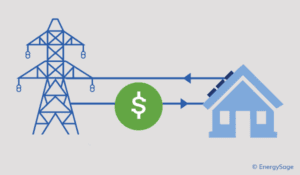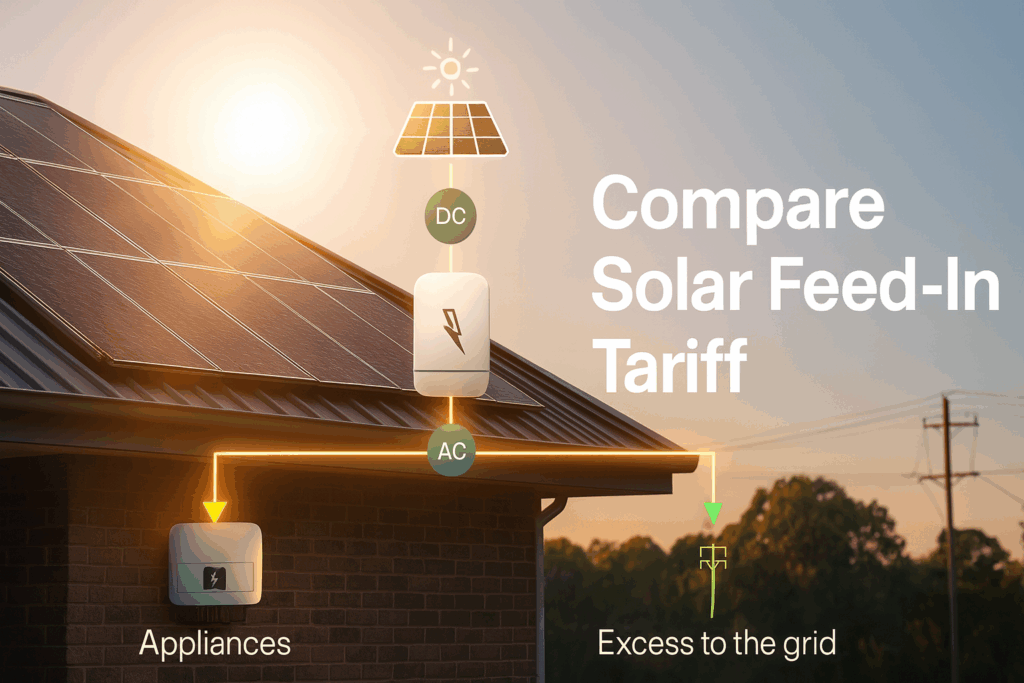Find how FiTs (solar buy-back credits) work in your state, then click through for live retailer rates and plan conditions.
New to FiTs? Start with the explainer: Solar Feed-in Tariffs (FiTs) in Australia: A Homeowner’s Guide.
How to use this page
Do a quick bill check (2 minutes): From your last bill, note kWh bought, kWh exported, and daily supply charge. A higher FiT can be outweighed if usage or supply charges are higher too.
Pick your state below to see live FiT rates and plan conditions.
Compare the whole plan, not just the FiT: usage rate (what you pay), daily supply charge, any export caps, and time-of-day credits.
Choose Your State
State Solar Feed-In Tariffs Explained
Available Feed-In Tariff schemes
Current solar feed-in schemes by state/territory
| State / Territory | Who sets the FiT? | Official rules | Export limits / network rules (DNSP) | Compare Live rates |
|---|---|---|---|---|
| VIC | Retailer-set (no regulated minimum from 1 Jul 2025) | Essential Services Commission – Solar feed-in tariffs | VIC – Who is my distributor? (CitiPower / Powercor / United Energy / Jemena / AusNet) | Best FiTs in VIC |
| NSW | Retailer-set (IPART issues non-binding benchmark) | IPART – Solar feed-in tariff benchmarks | Ausgrid · Endeavour Energy · Essential Energy | Best FiTs in NSW |
| QLD (SE – Energex) | Retailer-set (no minimum) | QLD Govt energy policy (retailer-set FiT) — see your retailer’s T&Cs | Energex | Best FiTs in QLD (SE) |
| QLD (Regional – Ergon) | Minimum FiT set annually by QCA | Queensland Competition Authority – Regional solar FiT | Ergon Energy Network | Best FiTs in QLD (Regional) |
| SA | Retailer-set (no minimum) | SA Govt energy policy (retailer-set FiT) — see your retailer’s T&Cs | SA Power Networks – export & technical | Best FiTs in SA |
| WA (Synergy – SWIS) | State scheme (DEBS – time-of-export buyback) | WA Govt – Energy Buyback Scheme (DEBS) · Synergy – DEBS | Western Power – connections/exports | Best FiTs in WA (Synergy) |
| WA (Horizon – regional) | Town-based buyback schemes | Horizon Power – Buyback/DEBS | Horizon Power – hosting capacity/limits | Best FiTs in WA (Horizon) |
| ACT | Retailer-set (no minimum) | ACT Govt energy policy — see your retailer’s FiT T&Cs | Evoenergy – export/technical | Best FiTs in ACT |
| TAS | Regulated minimum set by OTTER | OTTER – Regulated FiT | TasNetworks – connections/exports | Best FiTs in TAS |
| NT | Retailer schemes (e.g., Jacana Solar Buyback) | Jacana Energy – Solar Buyback | Power and Water – rooftop solar & export | Best FiTs in NT |
How to use this table
- Click your state’s “Best FiTs” link to see live retailer rates and conditions on Solar Choice.
- Use the Official rules link if you need to confirm the scheme settings (e.g., VIC deregulation, QLD regional minimum, WA DEBS windows).
- Check Export limits with your local network (DNSP) before upsizing your system or adding a battery—limits can cap what you’re allowed to send to the grid.
Compare electricity plans & FiTs in your area now
Frequently Asked Questions
How does the solar feed-in tariff work?
What’s the difference between flat and time-of-day FiTs?
A flat FiT pays the same credit all day. Time-of-day FiTs change by export window (often lower around midday and higher late afternoon/evening). WA’s DEBS is a state scheme that pays by time of export.
Is the solar feed-in tariff taxable?
Are solar feed-in tariffs ending?
Compare electricity plans & FiTs in your area now
- Running Cost of Air Conditioners – Explained - 7 October, 2025
- Air Conditioner Rebate South Australia: What You Need to Know - 19 September, 2025
- Air Conditioner Rebates in Queensland: What You Need to Know - 19 September, 2025
